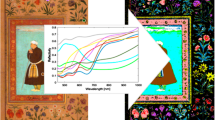Abstract
Hyperspectral imaging has been used for pigment characterization on paintings for the last 10 years. It is a noninvasive technique, which mixes the power of spectrophotometry and that of imaging technologies. We have access to a visible and near-infrared hyperspectral camera, ranging from 400 to 1000 nm in 80–160 spectral bands. In order to treat the large amount of data that this imaging technique generates, one can use statistical tools such as principal component analysis (PCA). To conduct the characterization of pigments, researchers mostly use PCA, convex geometry algorithms and the comparison of resulting clusters to database spectra with a specific tolerance (like the Spectral Angle Mapper tool on the dedicated software ENVI). Our approach originates from false-color photography and aims at providing a simple tool to identify pigments thanks to imaging spectroscopy. It can be considered as a quick first analysis to see the principal pigments of a painting, before using a more complete multivariate statistical tool. We study pigment spectra, for each kind of hue (blue, green, red and yellow) to identify the wavelength maximizing spectral differences. The case of red pigments is most interesting because our methodology can discriminate the red pigments very well—even red lakes, which are always difficult to identify. As for the yellow and blue categories, it represents a good progress of IRFC photography for pigment discrimination. We apply our methodology to study the pigments on a painting by Eustache Le Sueur, a French painter of the seventeenth century. We compare the results to other noninvasive analysis like X-ray fluorescence and optical microscopy. Finally, we draw conclusions about the advantages and limits of the variable false-color image method using hyperspectral imaging.















Similar content being viewed by others
References
A.F.H. Goetz, Three decades of hyperspectral remote sensing of the Earth: a personal view. Remote Sens. Environ. 113(Supplement 1), S5–S16 (2009)
F. Chaudhry, C.-C. Wu et al., Pixel Purity Index-Based Algorithms for Endmember Extraction from Hyperspectral Imagery, Recent Advances in Hyperspectral Signal and Image Processing, Chang, C.-I. (Transworld Research Network, India, 2006)
F.A. Kruse, J.W. Boardman, et al., Using Hyperspectral Data for Urban Baseline Studies, Boulder, Colorado, from http://www.hgimaging.com/PDF/Kruse-JPL2004_Boulder_Urban.pdf (2004)
J.K. Delaney, E. Walmsley, et al., Multispectral imaging of paintings in the infrared to detect and map blue pigments, Sackler NAS Colloquium, Scientific examination of Art: Modern techniques in conservation and analysis; in Proceedings of the National Academy of sciences (2005)
M. Klein, B. Aalderink et al., Quantitative hyperspectral reflectance imaging. Sensors 8, 5576–5618 (2008)
J.K. Delaney, J.G. Zeibel, et al., Visible and Infrared Reflectance Imaging Spectroscopy of Paintings: Pigment Mapping and Improved Infrared Reflectography, SPIE (2009)
K.A. Dooley, D.M. Conover, et al., Complementary Standoff Chemical Imaging to Map and Identify artist Materials in an Early Italian Renaissance Panel Painting, Angewandte Chemie, International Edition, 53, (2014)
H. Kühn, Terminal Dates for Paintings Derived from Pigment Analysis (Application of science in examination of works of art, Museum of Fine Arts, Boston, 1970)
R.L. Feller, Artists’ Pigments: A Handbook of Their History and Characteristics (Cambridge University Press, New York, 1987)
A. Roy, Artists’ Pigments: A Handbook of Their History and Characteristics (Oxford University Press, New York, 1993)
E. West Fitzhugh, Artists’ Pigments: A Handbook of Their History and Characteristics (Oxford University Press, New York, 1997)
B.H. Berrie, Artists’ Pigments: A Handbook of Their History and Characteristics (National Gallery of Art and Archetype Publications, Washington, 2007)
A. Aldrovandi, D. Bertani et al., Multispectral image processing of paintings. Stud. Conserv. 33, 154–159 (1988)
C. Hoeniger, The identification of blue pigments in early sienese paintings by color infrared photography. J. Am. Inst. Conserv. 30, 115–124 (1991)
T. Moon, M.R. Schilling et al., A note on the use of false-color infrared photography in conservation. Stud. Conserv. 37, 42–52 (1992)
A. Paounov, L’ultraviolet fausses couleurs : une méthode d’identification des pigments picturaux—Vers un protocole de prise de vue destiné à l’ultraviolet, under the supervision of Elisabeth Ravaud and Alain Sarlat, Ecole Nationale Supérieure Louis Lumière (2009)
E. Ravaud, E. Lambert, Imagerie scientifique des oeuvres d’art, in Seminar of the Institut National du Patrimoine, Marseille (2012)
J.-C. Dran, E. Laval, X-ray fluorescence (XRF), Scientific Examination for the Investigation of Paintings—A Handbook for Conservators Restorers (Centro Di, Florence, 2009)
R. Mazzeo, S. Prati, et al., Optical microscopy, Scientific Examination for the Investigation of Paintings—A Handbook for Conservators-Restorers (Centro Di, Florence, 2009)
A. Hayem-Ghez, Caractérisation des pigments sur les peintures de chevalet par méthodes optiques non-invasives, Ph.D. study, Cergy-Pontoise University (2015)
Author information
Authors and Affiliations
Corresponding author
Rights and permissions
About this article
Cite this article
Hayem-Ghez, A., Ravaud, E., Boust, C. et al. Characterizing pigments with hyperspectral imaging variable false-color composites. Appl. Phys. A 121, 939–947 (2015). https://doi.org/10.1007/s00339-015-9458-8
Received:
Accepted:
Published:
Issue Date:
DOI: https://doi.org/10.1007/s00339-015-9458-8




